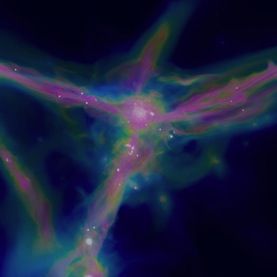
By peering into the distance with the biggest and best telescopes in the world, astronomers have managed to glimpse exploding stars, galaxies and other glowing cosmic beacons as they appeared just hundreds of millions of years after the big bang. They are so far away that their light is only now reaching Earth, even though it was emitted more than 13 billion years ago.
Astronomers have been able to identify those objects in the early universe because their bright glow has remained visible even after a long, universe-spanning journey. But spotting the raw materials from which the first cosmic structures formed - the gas produced as the infant universe expanded and cooled in the first few minutes after the big bang - has not been possible. That material is not itself luminous, and everywhere astronomers have looked they have found not the primordial light-element gases hydrogen, helium and lithium from the big bang but rather material polluted by heavier elements, which form only in stellar interiors and in cataclysms such as supernovae.
Now a group of researchers reports identifying the first known pockets of pristine gas, two relics of those first minutes of the universe's existence. The team found a pair of gas clouds that contain no detectable heavy elements whatsoever by looking at distant quasars and the intervening material they illuminate. Quasars are bright objects powered by a ravenous black hole, and the spectral quality of their light reveals what it passed through on its way to Earth, in much the same way that the lamp of a projector casts the colors of film onto a screen. The findings appeared online November 10 in Science.
"We found two gas clouds that show a significant abundance of hydrogen, so we know that they are there," says lead study author Michele Fumagalli, a graduate student at the University of California, Santa Cruz. One of the clouds also shows traces of deuterium, also known as heavy hydrogen, the nucleus of which contains not only a proton, as ordinary hydrogen does, but also a neutron. Deuterium should have been produced in big bang nucleosynthesis but is easily destroyed, so its presence is indicative of a pristine environment. The amount of deuterium present agrees with theoretical predictions about the mixture of elements that should have emerged from the big bang. "But we don't see any trace of heavier elements like carbon, oxygen and iron," Fumagalli says. "That's what tells us that this is primordial gas."
The newfound gas clouds, as Fumagalli and his colleagues see them, existed about two billion years after the big bang, at an epoch of cosmic evolution known as redshift 3. (Redshift is a sort of cosmological distance measure, corresponding to the degree that light waves have been stretched on their trip across an expanding universe.) By that time the first generation of stars, initially comprising only the primordial light elements, had formed and were distributing the heavier elements they forged via nuclear fusion reactions into interstellar space.
But the new study shows that some nooks of the universe remained pristine long after stars had begun to spew heavy elements. "They have looked for these special corners of the universe, where things just haven't been polluted yet," says Massachusetts Institute of Technology astronomer Rob Simcoe, who did not contribute to the new study. "Everyplace else that we've looked in these environments, we do find these heavy elements."
The pristine quality of the gas clouds begs the question: Why did heavy elements, which should already have been relatively abundant two billion years after the big bang, fail to reach the gas clouds? There are two possibilities, Simcoe says. "Is it the case that there are no heavy elements there or that there are some, but they haven't mixed into the clouds that they see?" he asks. In some sense, he adds, it is a surprise that gas from the dawn of the universe, unsullied by heavy elements, has escaped detection for so long. "It takes a while for these elements to be fused, and it takes even longer to leak into their surroundings," Simcoe says. "There must be other regions of the universe that are like this."
Fumagalli says that his group will continue to look for quasar-lit primordial gas clouds to learn more about where they existed and how they eluded contamination. "We pretty much just started, and we immediately found these two gas clouds, so we don't know how common these clouds are," he says.



Reader Comments
to our Newsletter